Question
Let \(f(x) = \ln (x + 5) + \ln 2\) , for \(x > – 5\) .
Find \({f^{ – 1}}(x)\) .
Let \(g(x) = {{\rm{e}}^x}\) .
Find \((g \circ f)(x)\) , giving your answer in the form \(ax + b\) , where \(a,b \in \mathbb{Z}\) .
Answer/Explanation
Markscheme
METHOD 1
\(\ln (x + 5) + \ln 2 = \ln (2(x + 5))\) \(( = \ln (2x + 10))\) (A1)
interchanging x and y (seen anywhere) (M1)
e.g. \(x = \ln (2y + 10)\)
evidence of correct manipulation (A1)
e.g. \({{\rm{e}}^x} = 2y + 10\)
\({f^{ – 1}}(x) = \frac{{{{\rm{e}}^x} – 10}}{2}\) A1 N2
METHOD 2
\(y = \ln (x + 5) + \ln 2\)
\(y – \ln 2 = ln(x + 5)\) (A1)
evidence of correct manipulation (A1)
e.g. \({{\rm{e}}^{y – \ln 2}} = x + 5\)
interchanging x and y (seen anywhere) (M1)
e.g. \({{\rm{e}}^{x – \ln 2}} = y + 5\)
\({f^{ – 1}}(x) = {{\rm{e}}^{x – \ln 2}} – 5\) A1 N2
[4 marks]
METHOD 1
evidence of composition in correct order (M1)
e.g. \((g \circ f)(x) = g(\ln (x + 5) + \ln 2)\)
\( = {{\rm{e}}^{\ln (2(x + 5))}} = 2(x + 5)\)
\((g \circ f)(x) = 2x + 10\) A1A1 N2
METHOD 2
evidence of composition in correct order (M1)
e.g. \((g \circ f)(x) = {{\rm{e}}^{\ln (x + 5) + \ln 2}}\)
\( = {{\rm{e}}^{\ln (x + 5)}} \times {{\rm{e}}^{\ln 2}} = (x + 5)2\)
\((g \circ f)(x) = 2x + 10\) A1A1 N2
[3 marks]
Question
Let \(f(x) = {{\rm{e}}^{x + 3}}\) .
(i) Show that \({f^{ – 1}}(x) = \ln x – 3\) .
(ii) Write down the domain of \({f^{ – 1}}\) .
Solve the equation \({f^{ – 1}}(x) = \ln \frac{1}{x}\) .
Answer/Explanation
Markscheme
(i) interchanging x and y (seen anywhere) M1
e.g. \(x = {{\rm{e}}^{y + 3}}\)
correct manipulation A1
e.g. \(\ln x = y + 3\) , \(\ln y = x + 3\)
\({f^{ – 1}}(x) = \ln x – 3\) AG N0
(ii) \(x > 0\) A1 N1
[3 marks]
collecting like terms; using laws of logs (A1)(A1)
e.g. \(\ln x – \ln \left( {\frac{1}{x}} \right) = 3\) , \(\ln x + \ln x = 3\) , \(\ln \left( {\frac{x}{{\frac{1}{x}}}} \right) = 3\) , \(\ln {x^2} = 3\)
simplify (A1)
e.g. \(\ln x = \frac{3}{2}\) , \({x^2} = {{\rm{e}}^3}\)
\(x = {{\rm{e}}^{\frac{3}{2}}}\left( { = \sqrt {{{\rm{e}}^3}} } \right)\) A1 N2
[4 marks]
Question
Let \(f(x) = {x^2}\) and \(g(x) = 2x – 3\) .
Find \({g^{ – 1}}(x)\) .
Find \((f \circ g)(4)\) .
Answer/Explanation
Markscheme
for interchanging x and y (may be done later) (M1)
e.g. \(x = 2y – 3\)
\({g^{ – 1}}(x) = \frac{{x + 3}}{2}\) (accept \(y = \frac{{x + 3}}{2},\frac{{x + 3}}{2}\) ) A1 N2
[2 marks]
METHOD 1
\(g(4) = 5\) (A1)
evidence of composition of functions (M1)
\(f(5) = 25\) A1 N3
METHOD 2
\(f \circ g(x) = {(2x – 3)^2}\) (M1)
\(f \circ g(4) = {(2 \times 4 – 3)^2}\) (A1)
= 25 A1 N3
[3 marks]
Question
Let \(f(x) = 2{x^3} + 3\) and \(g(x) = {{\rm{e}}^{3x}} – 2\) .
(i) Find \(g(0)\) .
(ii) Find \((f \circ g)(0)\) .
Find \({f^{ – 1}}(x)\) .
Answer/Explanation
Markscheme
(i) \(g(0) = {{\rm{e}}^0} – 2\) (A1)
\( = – 1\) A1 N2
(ii) METHOD 1
substituting answer from (i) (M1)
e.g. \((f \circ g)(0) = f( – 1)\)
correct substitution \(f( – 1) = 2{( – 1)^3} + 3\) (A1)
\(f( – 1) = 1\) A1 N3
METHOD 2
attempt to find \((f \circ g)(x)\) (M1)
e.g. \((f \circ g)(x) = f({{\rm{e}}^{3x}} – 2)\) \( = 2{({{\rm{e}}^{3x}} – 2)^3} + 3\)
correct expression for \((f \circ g)(x)\) (A1)
e.g. \(2{({{\rm{e}}^{3x}} – 2)^3} + 3\)
\((f \circ g)(0) = 1\) A1 N3
[5 marks]
interchanging x and y (seen anywhere) (M1)
e.g. \(x = 2{y^3} + 3\)
attempt to solve (M1)
e.g. \({y^3} = \frac{{x – 3}}{2}\)
\({f^{ – 1}}(x) = \sqrt[3]{{\frac{{x – 3}}{2}}}\) A1 N3
[3 marks]
Question
Let \(f(x) = k{\log _2}x\) .
Given that \({f^{ – 1}}(1) = 8\) , find the value of \(k\) .
Find \({f^{ – 1}}\left( {\frac{2}{3}} \right)\) .
Answer/Explanation
Markscheme
METHOD 1
recognizing that \(f(8) = 1\) (M1)
e.g. \(1 = k{\log _2}8\)
recognizing that \({\log _2}8 = 3\) (A1)
e.g. \(1 = 3k\)
\(k = \frac{1}{3}\) A1 N2
METHOD 2
attempt to find the inverse of \(f(x) = k{\log _2}x\) (M1)
e.g. \(x = k{\log _2}y\) , \(y = {2^{\frac{x}{k}}}\)
substituting 1 and 8 (M1)
e.g. \(1 = k{\log _2}8\) , \({2^{\frac{1}{k}}} = 8\)
\(k = \frac{1}{{{{\log }_2}8}}\) \(\left( {k = \frac{1}{3}} \right)\) A1 N2
[3 marks]
METHOD 1
recognizing that \(f(x) = \frac{2}{3}\) (M1)
e.g. \(\frac{2}{3} = \frac{1}{3}{\log _2}x\)
\({\log _2}x = 2\) (A1)
\({f^{ – 1}}\left( {\frac{2}{3}} \right) = 4\) (accept \(x = 4\)) A2 N3
METHOD 2
attempt to find inverse of \(f(x) = \frac{1}{3}{\log _2}x\) (M1)
e.g. interchanging x and y , substituting \(k = \frac{1}{3}\) into \(y = {2^{\frac{x}{k}}}\)
correct inverse (A1)
e.g. \({f^{ – 1}}(x) = {2^{3x}}\) , \({2^{3x}}\)
\({f^{ – 1}}\left( {\frac{2}{3}} \right) = 4\) A2 N3
[4 marks]
Question
Let \(f(x) = lo{g_3}\sqrt x \) , for \(x > 0\) .
Show that \({f^{ – 1}}(x) = {3^{2x}}\) .
Write down the range of \({f^{ – 1}}\) .
Let \(g(x) = {\log _3}x\) , for \(x > 0\) .
Find the value of \(({f^{ – 1}} \circ g)(2)\) , giving your answer as an integer.
Answer/Explanation
Markscheme
interchanging x and y (seen anywhere) (M1)
e.g. \(x = \log \sqrt y \) (accept any base)
evidence of correct manipulation A1
e.g. \(3^x = \sqrt y \) , \({3^y} = {x^{\frac{1}{2}}}\) , \(x = \frac{1}{2}{\log _3}y\) , \(2y = {\log _3}x\)
\({f^{ – 1}}(x) = {3^{2x}}\) AG N0
[2 marks]
\(y > 0\) , \({f^{ – 1}}(x) > 0\) A1 N1
[1 mark]
METHOD 1
finding \(g(2) = lo{g_3}2\) (seen anywhere) A1
attempt to substitute (M1)
e.g. \(({f^{ – 1}} \circ g)(2) = {3^{2\log {_3}2}}\)
evidence of using log or index rule (A1)
e.g. \(({f^{ – 1}} \circ g)(2) = {3^{\log {_3}4}}\) , \({3^{{{\log }_3}2^2}}\)
\(({f^{ – 1}} \circ g)(2) = 4\) A1 N1
METHOD 2
attempt to form composite (in any order) (M1)
e.g. \(({f^{ – 1}} \circ g)(x) = {3^{2{{\log }_3}x}}\)
evidence of using log or index rule (A1)
e.g. \(({f^{ – 1}} \circ g)(x) = {3^{{{\log }_3}{x^2}}}\) , \({3^{{{\log }_3}{x^{}}}}^2\)
\(({f^{ – 1}} \circ g)(x) = {x^2}\) A1
\(({f^{ – 1}} \circ g)(2) = 4\) A1 N1
[4 marks]
c.
Question
Let \(f(x) = 7 – 2x\) and \(g(x) = x + 3\) .
Find \((g \circ f)(x)\) .
Write down \({g^{ – 1}}(x)\) .
Find \((f \circ {g^{ – 1}})(5)\) .
Answer/Explanation
Markscheme
attempt to form composite (M1)
e.g. \(g(7 – 2x)\) , \(7 – 2x + 3\)
\((g \circ f)(x) = 10 – 2x\) A1 N2
[2 marks]
\({g^{ – 1}}(x) = x – 3\) A1 N1
[1 mark]
METHOD 1
valid approach (M1)
e.g. \({g^{ – 1}}(5)\) , \(2\) , \(f(5)\)
\(f(2) = 3\) A1 N2
METHOD 2
attempt to form composite of f and \({g^{ – 1}}\) (M1)
e.g. \((f \circ {g^{ – 1}})(x) = 7 – 2(x – 3)\) , \(13 – 2x\)
\((f \circ {g^{ – 1}})(5) = 3\) A1 N2
[2 marks]
Question
Let \(f(x) = {\log _p}(x + 3)\) for \(x > – 3\) . Part of the graph of f is shown below.
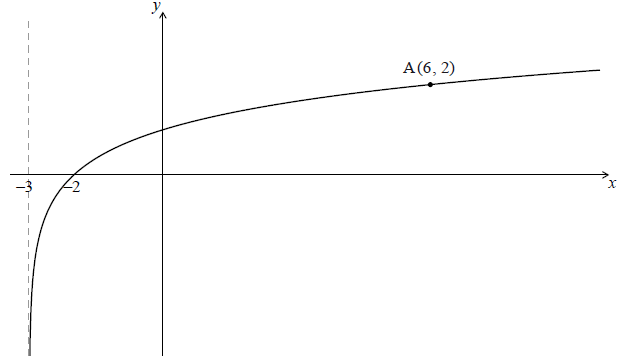
The graph passes through A(6, 2) , has an x-intercept at (−2, 0) and has an asymptote at \(x = – 3\) .
Find p .
The graph of f is reflected in the line \(y = x\) to give the graph of g .
(i) Write down the y-intercept of the graph of g .
(ii) Sketch the graph of g , noting clearly any asymptotes and the image of A.
The graph of \(f\) is reflected in the line \(y = x\) to give the graph of \(g\) .
Find \(g(x)\) .
Answer/Explanation
Markscheme
evidence of substituting the point A (M1)
e.g. \(2 = {\log _p}(6 + 3)\)
manipulating logs A1
e.g. \({p^2} = 9\)
\(p = 3\) A2 N2
[4 marks]
(i) \(y = – 2\) (accept \((0{\text{, }} – 2))\) A1 N1
(ii)
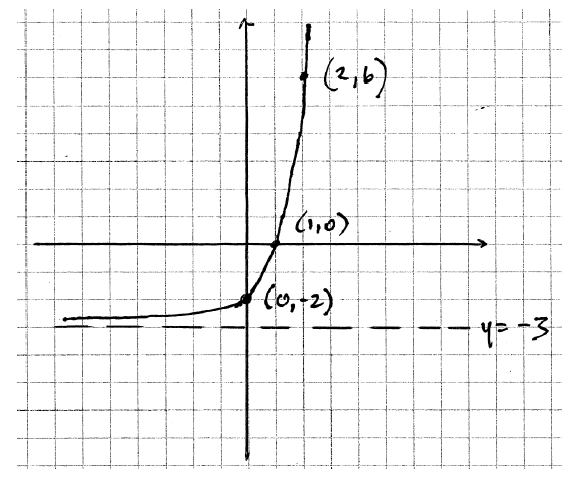 A1A1A1A1 N4
A1A1A1A1 N4
Note: Award A1 for asymptote at \(y = – 3\) , A1 for an increasing function that is concave up, A1 for a positive x-intercept and a negative y-intercept, A1 for passing through the point \((2{\text{, }}6)\) .
[5 marks]
METHOD 1
recognizing that \(g = {f^{ – 1}}\) (R1)
evidence of valid approach (M1)
e.g. switching x and y (seen anywhere), solving for x
correct manipulation (A1)
e.g. \({3^x} = y + 3\)
\(g(x) = {3^x} – 3\) A1 N3
METHOD 2
recognizing that \(g(x) = {a^x} + b\) (R1)
identifying vertical translation (A1)
e.g. graph shifted down 3 units, \(f(x) – 3\)
evidence of valid approach (M1)
e.g. substituting point to identify the base
\(g(x) = {3^x} – 3\) A1 N3
[4 marks]
Question
Let \(f(x) = 2x – 1\) and \(g(x) = 3{x^2} + 2\) .
Find \({f^{ – 1}}(x)\) .
Find \((f \circ g)(1)\) .
Answer/Explanation
Markscheme
interchanging x and y (seen anywhere) (M1)
e.g. \(x = 2y – 1\)
correct manipulation (A1)
e.g. \(x + 1 = 2y\)
\({f^{ – 1}}(x) = \frac{{x + 1}}{2}\) A1 N2
[3 marks]
METHOD 1
attempt to find or \(g(1)\) or \(f(1)\) (M1)
\(g(1) = 5\) (A1)
\(f(5) = 9\) A1 N2
[3 marks]
METHOD 2
attempt to form composite (in any order) (M1)
e.g. \(2(3{x^2} + 2) – 1\) , \(3{(2x – 1)^2} + 2\)
\((f \circ g)(1) = 2(3 \times {1^2} + 2) – 1\) \(( = 6 \times {1^2} + 3)\) (A1)
\((f \circ g)(1) = 9\) A1 N2
[3 marks]
Question
Let \(f(x) = \sqrt {x – 5} \) , for \(x \ge 5\) .
Find \({f^{ – 1}}(2)\) .
Let \(g\) be a function such that \({g^{ – 1}}\) exists for all real numbers. Given that \(g(30) = 3\) , find \((f \circ {g^{ – 1}})(3)\) .
Answer/Explanation
Markscheme
METHOD 1
attempt to set up equation (M1)
eg \(2 = \sqrt {y – 5} \) , \(2 = \sqrt {x – 5} \)
correct working (A1)
eg \(4 = y – 5\) , \(x = {2^2} + 5\)
\({f^{ – 1}}(2) = 9\) A1 N2
METHOD 2
interchanging \(x\) and \(y\) (seen anywhere) (M1)
eg \(x = \sqrt {y – 5} \)
correct working (A1)
eg \({x^2} = y – 5\) , \(y = {x^2} + 5\)
\({f^{ – 1}}(2) = 9\) A1 N2
[3 marks]
recognizing \({g^{ – 1}}(3) = 30\) (M1)
eg \(f(30)\)
correct working (A1)
eg \((f \circ {g^{ – 1}})(3) = \sqrt {30 – 5} \) , \(\sqrt {25} \)
\((f \circ {g^{ – 1}})(3) = 5\) A1 N2
Note: Award A0 for multiple values, eg \( \pm 5\) .
[3 marks]
Question
Let \(f(x) = 4x – 2\) and \(g(x) = – 2{x^2} + 8\) .
Find \({f^{ – 1}}(x)\) .
Find \((f \circ g)(1)\) .
Answer/Explanation
Markscheme
interchanging \(x\) and \(y\) (seen anywhere) (M1)
eg \(x = 4y – 2\)
evidence of correct manipulation (A1)
eg \(x + 2 = 4y\)
\({f^{ – 1}}(x) = \frac{{x + 2}}{4}\) (accept \(y = \frac{{x + 2}}{4}\) , \(\frac{{x + 2}}{4}\) , \({f^{ – 1}}(x) = \frac{1}{4}x + \frac{1}{2}\) A1 N2
[3 marks]
METHOD 1
attempt to substitute \(1\) into \(g(x)\) (M1)
eg \(g(1) = – 2 \times {1^2} + 8\)
\(g(1) = 6\) (A1)
\(f(6) = 22\) A1 N3
METHOD 2
attempt to form composite function (in any order) (M1)
eg \((f \circ g)(x) = 4( – 2{x^2} + 8) – 2\) \(( = – 8{x^2} + 30)\)
correct substitution
eg \((f \circ g)(1) = 4( – 2 \times {1^2} + 8) – 2\) , \( – 8 + 30\)
\(f(6) = 22\) A1 N3
[3 marks]
Question
The diagram below shows the graph of a function \(f\) , for \( – 1 \le x \le 2\) .
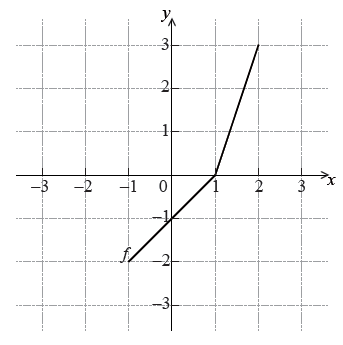
Write down the value of \(f(2)\).
Write down the value of \({f^{ – 1}}( – 1)\) .
Sketch the graph of \({f^{ – 1}}\) on the grid below.
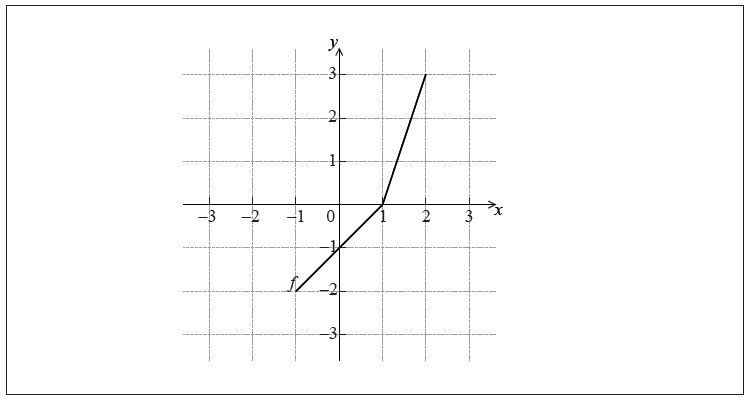
Answer/Explanation
Markscheme
\(f(2) = 3\) A1 N1
[1 mark]
\({f^{ – 1}}( – 1) = 0\) A2 N2
[2 marks]
EITHER
attempt to draw \(y = x\) on grid (M1)
OR
attempt to reverse x and y coordinates (M1)
eg writing or plotting at least two of the points
\(( – 2, – 1)\) , \(( – 1,0)\) , \((0,1)\) , \((3,2)\)
THEN
correct graph A2 N3
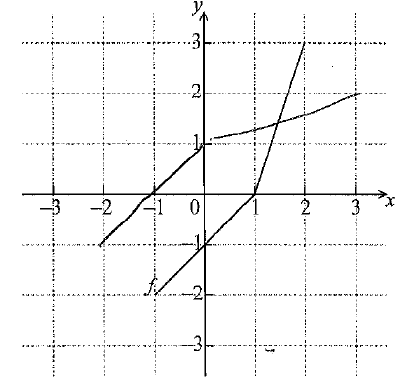
[3 marks]
Question
Let \(f(x) = 3x – 2\) and \(g(x) = \frac{5}{{3x}}\), for \(x \ne 0\).
Let \(h(x) = \frac{5}{{x + 2}}\), for \(x \geqslant 0\). The graph of h has a horizontal asymptote at \(y = 0\).
Find \({f^{ – 1}}(x)\).
Show that \(\left( {g \circ {f^{ – 1}}} \right)(x) = \frac{5}{{x + 2}}\).
Find the \(y\)-intercept of the graph of \(h\).
Hence, sketch the graph of \(h\).
For the graph of \({h^{ – 1}}\), write down the \(x\)-intercept;
For the graph of \({h^{ – 1}}\), write down the equation of the vertical asymptote.
Given that \({h^{ – 1}}(a) = 3\), find the value of \(a\).
Answer/Explanation
Markscheme
interchanging \(x\) and \(y\) (M1)
eg \(x = 3y – 2\)
\({f^{ – 1}}(x) = \frac{{x + 2}}{3}{\text{ }}\left( {{\text{accept }}y = \frac{{x + 2}}{3},{\text{ }}\frac{{x + 2}}{3}} \right)\) A1 N2
[2 marks]
attempt to form composite (in any order) (M1)
eg \(g\left( {\frac{{x + 2}}{3}} \right),{\text{ }}\frac{{\frac{5}{{3x}} + 2}}{3}\)
correct substitution A1
eg \(\frac{5}{{3\left( {\frac{{x + 2}}{3}} \right)}}\)
\(\left( {g \circ {f^{ – 1}}} \right)(x) = \frac{5}{{x + 2}}\) AG N0
[2 marks]
valid approach (M1)
eg \(h(0),{\text{ }}\frac{5}{{0 + 2}}\)
\(y = \frac{5}{2}{\text{ }}\left( {{\text{accept (0, 2.5)}}} \right)\) A1 N2
[2 marks]

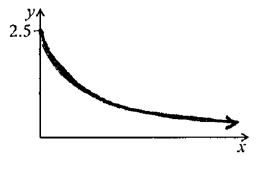
A1A2 N3
Notes: Award A1 for approximately correct shape (reciprocal, decreasing, concave up).
Only if this A1 is awarded, award A2 for all the following approximately correct features: y-intercept at \((0, 2.5)\), asymptotic to x-axis, correct domain \(x \geqslant 0\).
If only two of these features are correct, award A1.
[3 marks]
\(x = \frac{5}{2}{\text{ }}\left( {{\text{accept (2.5, 0)}}} \right)\) A1 N1
[1 mark]
\(x = 0\) (must be an equation) A1 N1
[1 mark]
METHOD 1
attempt to substitute \(3\) into \(h\) (seen anywhere) (M1)
eg \(h(3),{\text{ }}\frac{5}{{3 + 2}}\)
correct equation (A1)
eg \(a = \frac{5}{{3 + 2}},{\text{ }}h(3) = a\)
\(a = 1\) A1 N2
[3 marks]
METHOD 2
attempt to find inverse (may be seen in (d)) (M1)
eg \(x = \frac{5}{{y + 2}},{\text{ }}{h^{ – 1}} = \frac{5}{x} – 2,{\text{ }}\frac{5}{x} + 2\)
correct equation, \(\frac{5}{x} – 2 = 3\) (A1)
\(a = 1\) A1 N2
[3 marks]
Question
The following diagram shows the graph of \(y = f(x)\), for \( – 4 \le x \le 5\).
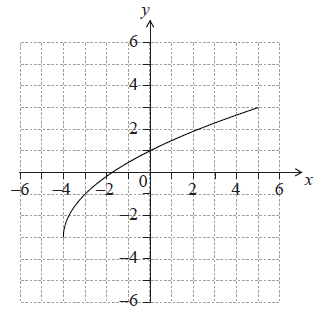
Write down the value of \(f( – 3)\).
Write down the value of \({f^{ – 1}}(1)\).
Find the domain of \({f^{ – 1}}\).
On the grid above, sketch the graph of \({f^{ – 1}}\).
Markscheme
\(f( – 3) = – 1\) A1 N1
[1 mark]
\({f^{ – 1}}(1) = 0\) (accept \(y = 0\)) A1 N1
[1 mark]
domain of \({f^{ – 1}}\) is range of \(f\) (R1)
eg \({\text{R}}f = {\text{D}}{f^{ – 1}}\)
correct answer A1 N2
eg \( – 3 \leqslant x \leqslant 3,{\text{ }}x \in [ – 3,{\text{ }}3]{\text{ (accept }} – 3 < x < 3,{\text{ }} – 3 \leqslant y \leqslant 3)\)
[2 marks]
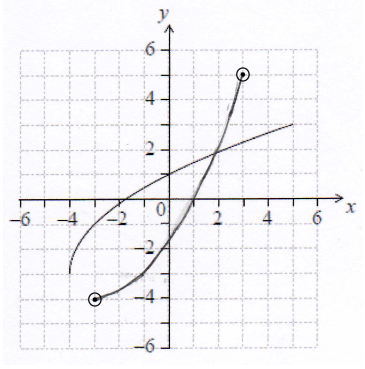 A1A1 N2
A1A1 N2
Note: Graph must be approximately correct reflection in \(y = x\).
Only if the shape is approximately correct, award the following:
A1 for x-intercept at \(1\), and A1 for endpoints within circles.
[2 marks]
Question
The following diagram shows the graph of a function \(f\).
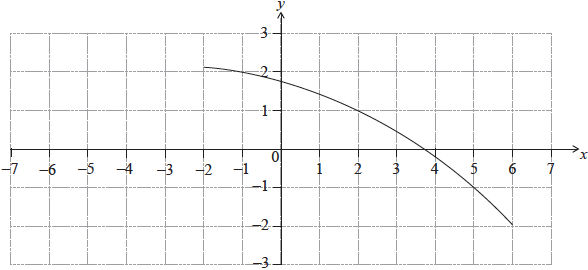
Find \({f^{ – 1}}( – 1)\).
Find \((f \circ f)( – 1)\).
On the same diagram, sketch the graph of \(y = f( – x)\).
Answer/Explanation
Markscheme
valid approach (M1)
eg\(\;\;\;\)horizontal line on graph at \( – 1,{\text{ }}f(a) = – 1,{\text{ }}( – 1,5)\)
\({f^{ – 1}}( – 1) = 5\) A1 N2
[2 marks]
attempt to find \(f( – 1)\) (M1)
eg\(\;\;\;\)line on graph
\(f( – 1) = 2\) (A1)
\((f \circ f)( – 1) = 1\) A1 N3
[3 marks]
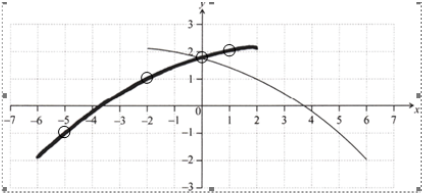 A1A1 N2
A1A1 N2
Note: The shape must be an approximately correct shape (concave down and increasing). Only if the shape is approximately correct, award the following for points in circles:
A1 for the \(y\)-intercept,
A1 for any two of these points \(( – 5,{\text{ }} – 1),{\text{ }}( – 2,{\text{ }}1),{\text{ }}(1,{\text{ }}2)\).
[2 marks]
Total [7 marks]
Question
Let \(f(x) = {(x – 5)^3}\), for \(x \in \mathbb{R}\).
Find \({f^{ – 1}}(x)\).
Let \(g\) be a function so that \((f \circ g)(x) = 8{x^6}\). Find \(g(x)\).
Answer/Explanation
Markscheme
interchanging \(x\) and \(y\) (seen anywhere) (M1)
eg\(\;\;\;x = {(y – 5)^3}\)
evidence of correct manipulation (A1)
eg\(\;\;\;y – 5 = \sqrt[3]{x}\)
\({f^{ – 1}}(x) = \sqrt[3]{x} + 5\;\;\;({\text{accept }}5 + {x^{\frac{1}{3}}},{\text{ }}y = 5 + \sqrt[3]{x})\) A1 N2
Notes: If working shown, and they do not interchange \(x\) and \(y\), award A1A1M0 for \(\sqrt[3]{y} + 5\).
If no working shown, award N1 for \(\sqrt[3]{y} + 5\).
METHOD 1
attempt to form composite (in any order) (M1)
eg\(\;\;\;g\left( {{{(x – 5)}^3}} \right),{\text{ }}{\left( {g(x) – 5} \right)^3} = 8{x^6},{\text{ }}f(2{x^2} + 5)\)
correct working (A1)
eg\(\;\;\;g – 5 = 2{x^2},{\text{ }}{\left( {(2{x^2} + 5) – 5} \right)^3}\)
\(g(x) = 2{x^2} + 5\) A1 N2
METHOD 2
recognising inverse relationship (M1)
eg\(\;\;\;{f^{ – 1}}(8{x^6}) = g(x),{\text{ }}{f^{ – 1}}(f \circ g)(x) = {f^{ – 1}}(8{x^6})\)
correct working
eg\(\;\;\;g(x) = \sqrt[3]{{(8{x^6})}} + 5\) (A1)
\(g(x) = 2{x^2} + 5\) A1 N2
Question
Let \(f(x) = 8x + 3\) and \(g(x) = 4x\), for \(x \in \mathbb{R}\).
Write down \(g(2)\).
Find \((f \circ g)(x)\).
Find \({f^{ – 1}}(x)\).
Answer/Explanation
Markscheme
\(g(2) = 8\) A1 N1
[1 mark]
attempt to form composite (in any order) (M1)
eg\(\,\,\,\,\,\)\(f(4x),{\text{ }}4 \times (8x + 3)\)
\((f \circ g)(x) = 32x + 3\) A1 N2
[2 marks]
interchanging \(x\) and \(y\) (may be seen at any time) (M1)
eg\(\,\,\,\,\,\)\(x = 8y + 3\)
\({f^{ – 1}}(x) = \frac{{x – 3}}{8}\,\,\,\,\,\left( {{\text{accept }}\frac{{x – 3}}{8},{\text{ }}y = \frac{{x – 3}}{8}} \right)\) A1 N2
[2 marks]
Question
Let \(f(x) = 5x\) and \(g(x) = {x^2} + 1\), for \(x \in \mathbb{R}\).
Find \({f^{ – 1}}(x)\).
Find \((f \circ g)(7)\).
Answer/Explanation
Markscheme
interchanging \(x\) and \(x\) (M1)
eg\(\,\,\,\,\,\)\(x = 5y\)
\({f^{ – 1}}\left( x \right) = \frac{x}{5}\) A1 N2
[2 marks]
METHOD 1
attempt to substitute 7 into \(g(x)\) or \(f(x)\) (M1)
eg\(\,\,\,\,\,\)\({7^2} + 1,{\text{ }}5 \times 7\)
\(g(7) = 50\) (A1)
\(f\left( {50} \right) = 250\) A1 N2
METHOD 2
attempt to form composite function (in any order) (M1)
eg\(\,\,\,\,\,\)\(5({x^2} + 1),{\text{ }}{(5x)^2} + 1\)
correct substitution (A1)
eg\(\,\,\,\,\,\)\(5 \times ({7^2} + 1)\)
\((f \circ g)(7) = 250\) A1 N2
[3 marks]
Question
The following diagram shows the graph of a function \(f\), with domain \( – 2 \leqslant x \leqslant 4\).
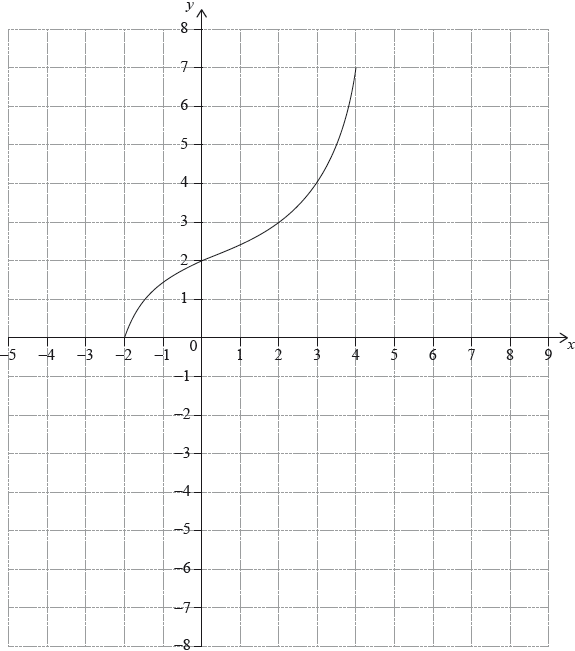
The points \(( – 2,{\text{ }}0)\) and \((4,{\text{ }}7)\) lie on the graph of \(f\).
Write down the range of \(f\).
Write down \(f(2)\);
Write down \({f^{ – 1}}(2)\).
On the grid, sketch the graph of \({f^{ – 1}}\).
Answer/Explanation
Markscheme
correct range (do not accept \(0 \leqslant x \leqslant 7\)) A1 N1
eg\(\,\,\,\,\,\)\([0,{\text{ }}7],{\text{ }}0 \leqslant y \leqslant 7\)
[1 mark]
\(f(2) = 3\) A1 N1
[1 mark]
\({f^{ – 1}}(2) = 0\) A1 N1
[1 mark]
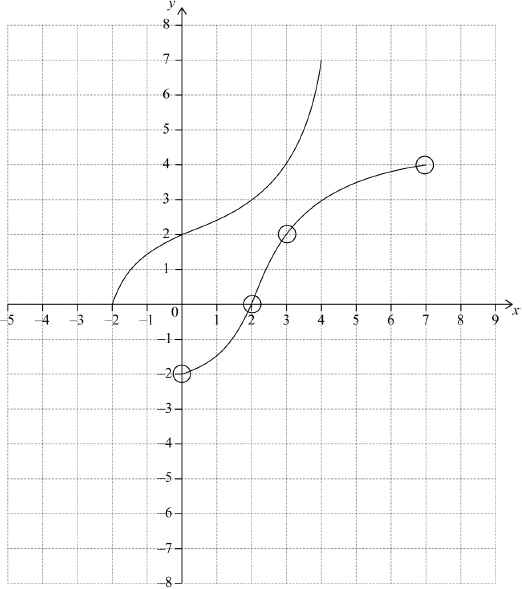 A1A1A1 N3
A1A1A1 N3
Notes: Award A1 for both end points within circles,
A1 for images of \((2,{\text{ }}3)\) and \((0,{\text{ }}2)\) within circles,
A1 for approximately correct reflection in \(y = x\), concave up then concave down shape (do not accept line segments).
[3 marks]
Question
Consider a function f (x) , for −2 ≤ x ≤ 2 . The following diagram shows the graph of f.
Write down the value of f (0).
Write down the value of f −1 (1).
Write down the range of f −1.
On the grid above, sketch the graph of f −1.
Answer/Explanation
Markscheme
\(f\left( 0 \right) = – \frac{1}{2}\) A1 N1
[1 mark]
f −1 (1) = 2 A1 N1
[1 mark]
−2 ≤ y ≤ 2, y∈ [−2, 2] (accept −2 ≤ x ≤ 2) A1 N1
[1 mark]
A1A1A1A1 N4
Note: Award A1 for evidence of approximately correct reflection in y = x with correct curvature.
(y = x does not need to be explicitly seen)
Only if this mark is awarded, award marks as follows:
A1 for both correct invariant points in circles,
A1 for the three other points in circles,
A1 for correct domain.
[4 marks]

